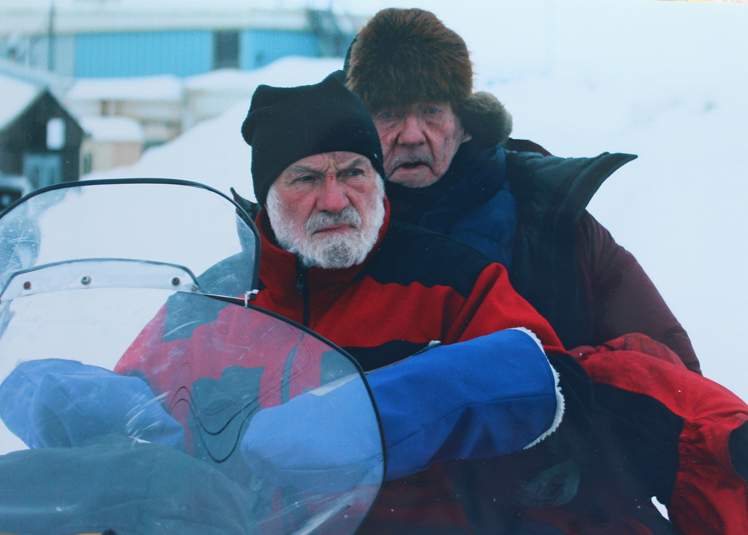For the 22nd year, Paul Sayer, a Homer physician, is getting ready to take the same two-week, mid-winter vacation he has taken every year before: traveling by snowmachine along the Iditarod sled dog race course to Nome. Once there, he turns around and heads back to where he started.
Not content to let him have all the fun, another local doctor, Paul Raymond, is going with him, a trip Raymond has made more than a dozen times. Accompanying Raymond for the second year is his daughter, Kendra, an eighth-grade student at Homer Middle School.
Also along for the fun, as he has been each of the past 22 years, is Sayer’s long-time friend Dick Newton of Takotna.
“We used to go out and break trail from Ophir to Ruby for the Iron Man or the Iditarod, that’s the most desolate part of the trail between Anchorage and Nome,” said Sayer of his and Newton’s volunteer efforts.
Sayer is familiar with the area because of the mine he operates near Takotna. “So he and I decided in 1992 that since we did trail-breaking, why shouldn’t we try to make it from Anchorage to Takotna to Nome.”
Having made the initial trial run, the two friends — Sayer is now 75 and Newton is 83 — decided one way wasn’t enough, so they turned around and followed their tracks right back to their starting point near Anchorage, a round-trip of about 2,000 miles.
That year, not knowing what to expect, they each towed sleds weighed down with everything they thought they might need including a barrel stove, a 10-foot wall tent, two chainsaws and plenty of extra fuel.
“We were sort of overloaded,” said Newton of the precautions the two took on that initial trip.
Two decades later, their loads are considerably lighter. With temperatures dropping into the minus-50s, they are careful to pack appropriate clothing, layers of fleece and boots with thick liners and spike-like soles. There are helmets, hats and gloves. Thick sleeping bags can be compressed to take up surprisingly little room. There are shovels and other essential equipment in case they have to get themselves out of some unexpected mess.
“This is the most important thing,” said Sayer, holding up a large peanut can.
It’s use: brewing camp coffee.
Over the years, Sayer and Newton have had an assortment of family members tag along. Sayer’s wife, Frankie, has made the trip, as have kids and grandkids and various friends. After a mishap last year, Raymond and his daughter weren’t going to repeat the trip but, at her urging, changed their plans.
“She actually flipped her machine, end over end, and she had a pretty good concussion,” said Raymond. “She wasn’t very happy that night and was a little delusional, but once she got a night’s rest, she was OK.”
Kendra, 14, said she doesn’t remember a lot about the accident, only that she “went end over end twice, had a pretty bad concussion and my hip was bruised.”
Any damage done to her adventuresome spirit quickly healed.
“Originally last year I said I’d never do it again and then I decided I would,” she said laughing. “I like snowmachining. I don’t do it that often, but I enjoy it. And it’s cool to be able to say I’ve done it.”
According to her dad, it also helped change her mind after they reached Nome and Iditarod musher Martin Buser said, “he only knew of four other girls that had made the trip and she was the second youngest. I think that was part of her motivation to do it again,” said Raymond.
There have been a few other injuries over the years.
“(Sayer) once fell into a crevasse, a creek, basically, about 10 feet down and broke his nose,” said Raymond.
While Sayer didn’t share that story, he did mention being pinned under his 600-pound Ski-Doo Expedition last year when it rolled over as he was attempting to turn around in a heavily wooded area. An Iditarod musher happened to come along and she was able to right the machine so Sayer could free himself.
Sayer, Newton and their traveling companions also have assisted in rescues, as well as recoveries after fatal airplane crashes along the route.
There have been occasional breakdowns of the machines they’ve used over the years. Once in awhile, as for Raymond and his daughter who decided not to make the round trip by snowmachine after they reached Nome in 2013, the snowmachines are flown one direction or the other.
Along the route, they’ve seen caribou, fox, wolves, coyotes, and musk ox. Twice, they’ve come upon moose that have died in the middle of narrow portions of the trail where the only option was to go over the frozen carcasses, requiring the travelers to create snow ramps.
Weather is always a factor.
“If it turns so warm that the rivers are breaking up or the Rainy Pass area is avalanching, we don’t go,” said Sayer. “We carry satellite phones, but don’t want to cause trouble. However, if it’s too dangerous, we’ll stop and fly the machines.”
That should be good news to Kendra’s middle school friends.
“They worry about me mostly, but they also think it’s pretty cool,” she said.
In the last 22 years, Sayer and Newton have become quite well known along the trail.
“We have so many friends that we can get help or food or a place to sleep. We camp out once in awhile, but practically never any more,” said Sayer. “We’ve made so many friends that it is kind of mind-boggling. I don’t know if anyone deserves as many friends as we’ve made.”
In spite of the number of times Sayer and Newton have made the journey, it continues to fuel their spirit of adventure.
“It’s the trip of a lifetime that we do every year,” said Sayer. “That’s why we keep staying alive.”
McKibben Jackinsky can be reached at mckibben.
jackinsky@homernews.com.


